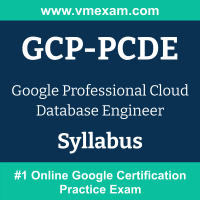 The Google GCP-PCDE exam preparation guide is designed to provide candidates with necessary information about the Professional Cloud Database Engineer exam. It includes exam summary, sample questions, practice test, objectives and ways to interpret the exam objectives to enable candidates to assess the types of questions-answers that may be asked during the Google Cloud Platform - Professional Cloud Database Engineer (GCP-PCDE) exam.
The Google GCP-PCDE exam preparation guide is designed to provide candidates with necessary information about the Professional Cloud Database Engineer exam. It includes exam summary, sample questions, practice test, objectives and ways to interpret the exam objectives to enable candidates to assess the types of questions-answers that may be asked during the Google Cloud Platform - Professional Cloud Database Engineer (GCP-PCDE) exam.
It is recommended for all the candidates to refer the GCP-PCDE objectives and sample questions provided in this preparation guide. The Google Professional Cloud Database Engineer certification is mainly targeted to the candidates who want to build their career in Professional domain and demonstrate their expertise. We suggest you to use practice exam listed in this cert guide to get used to with exam environment and identify the knowledge areas where you need more work prior to taking the actual Google Professional Cloud Database Engineer exam.
Google GCP-PCDE Exam Summary:
| Exam Name | Google Professional Cloud Database Engineer |
| Exam Code | Professional Cloud Database Engineer |
| Exam Price | $200 USD |
| Duration | 120 minutes |
| Number of Questions | 50-60 |
| Passing Score | Pass / Fail (Approx 70%) |
| Recommended Training / Books |
Google Cloud documentation Google Cloud solutions |
| Schedule Exam | Google CertMetrics |
| Sample Questions | Google GCP-PCDE Sample Questions |
| Recommended Practice | Google Cloud Platform - Professional Cloud Database Engineer (GCP-PCDE) Practice Test |
Google GCP-PCDE Syllabus:
| Section | Objectives |
|---|---|
Design innovative, scalable, and highly available cloud database solutions (~32% of the exam) |
|
| Analyze relevant variables to perform database capacity and usage planning Considerations include: |
- Perform solution sizing based on current environment workload metrics and future requirements - Evaluate performance and cost tradeos of dierent database congurations (e.g., machine types, storage types) - Size database compute and storage based on performance requirements |
| Evaluate database high availability and disaster recovery options given the requirements Considerations include: |
- Evaluate tradeos between multi-regional, regional, and zonal database deployment strategies - Dene maintenance windows and notications based on application availability requirements |
| Determine how applications will connect to the database Considerations include: |
- Configure networking, key management, encryption, and security - Justify the use of session pooler services - Assess auditing policies for managed services |
| Evaluate appropriate database solutions on Google Cloud |
- Dierentiate between managed and unmanaged database services (e.g., self-managed, bare metal, Google-managed, Google Cloud native and partner database oerings) - Distinguish between SQL and NoSQL business requirements (e.g., structured, semi-structured, unstructured, vector) - Analyze the cost of running database solutions in Google Cloud (comparative analysis) - Assess application and database dependencies - Identify solutions to support regulatory and compliance requirements - Understand implications of organizational policies on database strategy - Consider solutions that span multiple database technologies (e.g. federation, exports, hybrid deployments) - Leverage database technologies to support generative AI and LLM use cases |
Manage a solution that can span multiple database technologies (~25% of the exam) |
|
| Determine database connectivity and access management considerations Considerations include: |
- Determine Identity and Access Management (IAM) and policies for database connectivity and access control - Manage database users including authentication and access |
| Configure database monitoring and troubleshooting options Considerations include: |
- Assess slow running queries, database locking - identify missing indexes - Monitor and investigate database vitals - RAM, CPU storage, I/O, and audit logging - Monitor and update quotas - Investigate database resource contention - Set up alerts for errors and performance metrics |
| Design database backup and recovery solutions Considerations include: |
- Given requirements, recommend backup and recovery options (automatic scheduled backups) - Configure export and import data for databases - Design for RTO, RPO, and PITR - Manage data retention |
| Optimize database cost and performance in Google Cloud Considerations include: |
- Assess scaling up and scaling out options - Scale database instances based on current and upcoming workload - Define replication strategies - Continuously assess and optimize the cost of running a database solution - Optimize queries for cost and performance |
| Automate common database tasks Considerations include: |
- Perform database maintenance (e.g., rebuilding indexes, data exports) - Schedule database exports - Manage upgrades for Google Cloud-managed databases - Monitor database SLA/SLOs |
Migrate data solutions (~23% of the exam) |
|
| Design and implement data migration and replication Considerations include: |
- Develop and execute migration strategies and plans, including zero/near-zero downtime, extended outage, and fallback - Reverse replication from Google Cloud to source - Plan and perform database migration, including fallback plans and DDL/DML conversion - Determine the correct database migration tools for a given scenario (e.g., databases hosted outside of Google Cloud) |
Deploy scalable and highly available databases in Google Cloud (~20% of the exam) |
|
| Apply concepts to implement scalable and highly available databases in Google Cloud. Considerations include: |
- Provision highly available database solutions in Google Cloud - Test high availability and disaster recovery strategies - Set up multi-regional replication for databases - Deploy and scale read replicas - Automate database instance provisioning - Congure monitoring for highly available databases |
